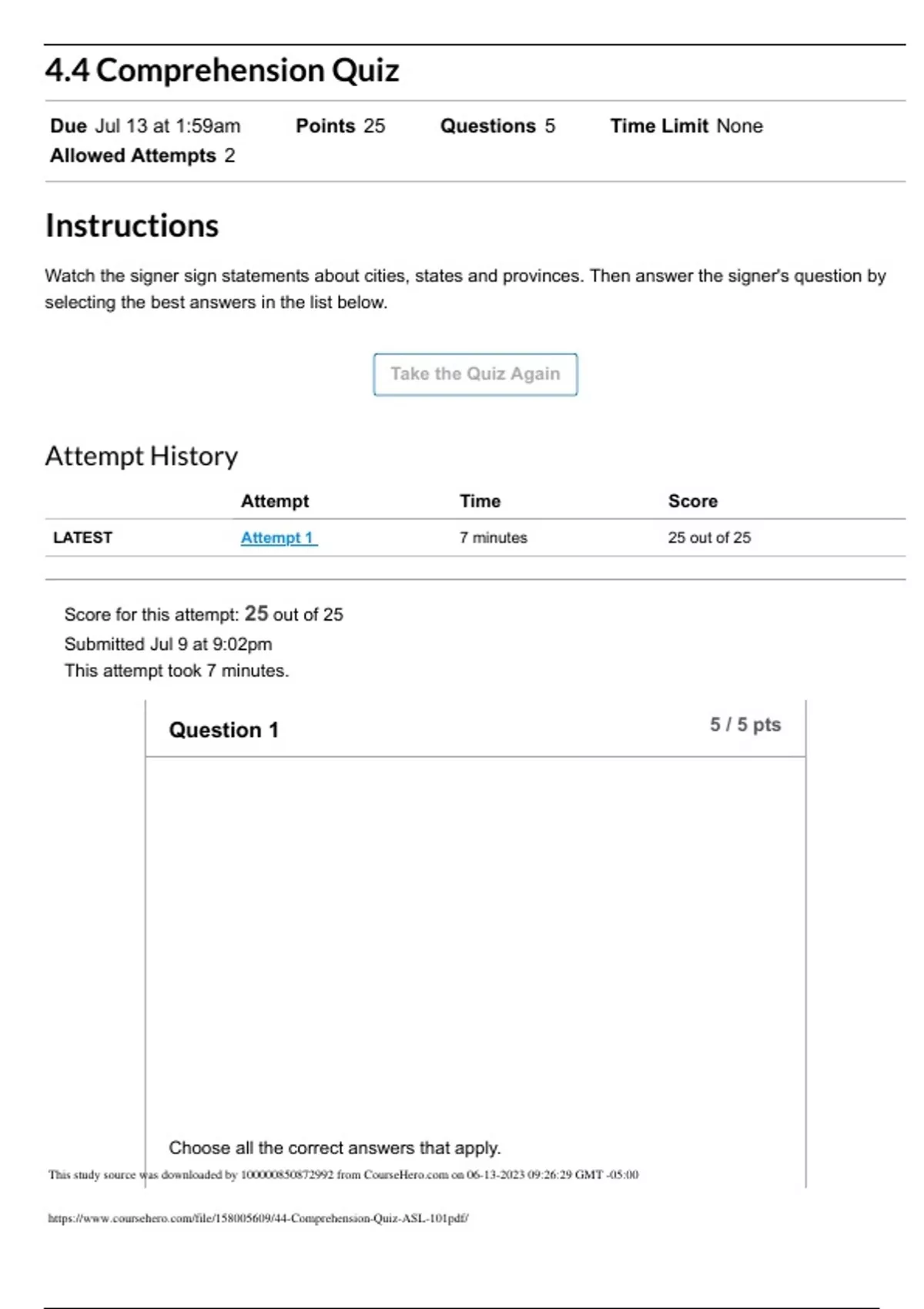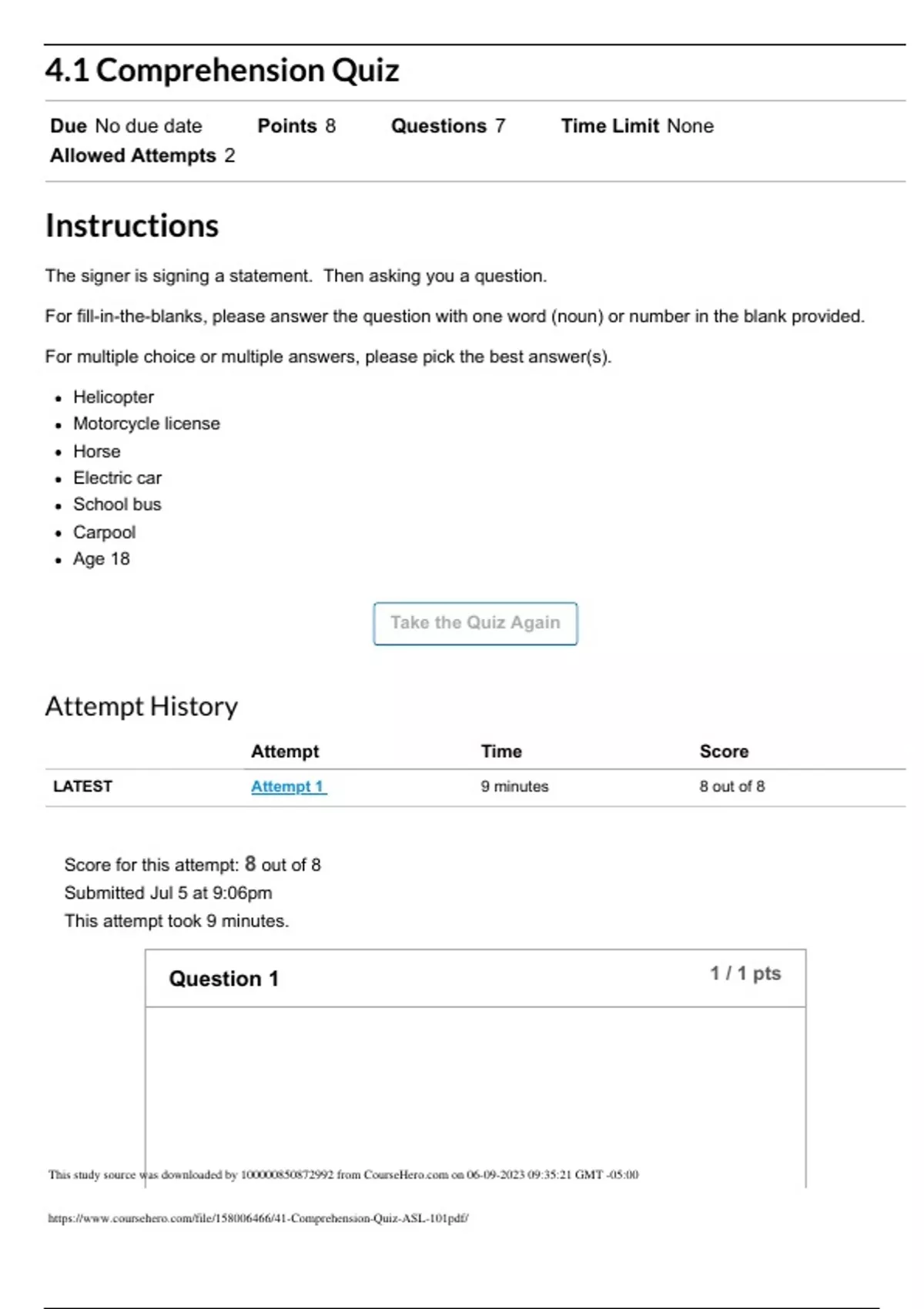Let’s face it, folks—ASL Unit 4 comprehension tests can be a real challenge if you’re not prepared. But don’t sweat it! This article is your go-to resource for everything you need to know about acing this test. Whether you’re a beginner or brushing up on your skills, we’ve got you covered with tips, tricks, and insights that’ll make you feel like a pro in no time.
Now, before we dive into the nitty-gritty, let’s get one thing straight: American Sign Language (ASL) is more than just hand gestures. It’s a beautiful form of communication with its own grammar, syntax, and cultural nuances. Unit 4 focuses on expanding your vocabulary and comprehension skills, so mastering this part is crucial if you want to take your signing to the next level.
Here’s the deal: if you’re reading this, chances are you’re either preparing for the ASL Unit 4 comprehension test or just trying to understand what it’s all about. Either way, you’ve come to the right place. We’ll break down the key concepts, give you practice tips, and even share some insider secrets that’ll make you feel unstoppable. So buckle up, buttercup, because we’re about to take this journey together!
Read also:Is Michael Consuelos Married A Deep Dive Into His Love Life
Understanding the Basics of ASL Unit 4
Before we get into the specifics of the comprehension test, let’s talk about what Unit 4 actually covers. This unit dives deep into topics like numbers, time, and daily routines. It’s not just about learning signs—it’s about understanding how to use them in context. Think of it like learning a new language: you don’t just memorize words; you learn how to string them together into meaningful sentences.
Here’s a quick rundown of what you’ll encounter in Unit 4:
- Numbers and counting (both fingerspelling and numerical signs)
- Time-related signs (days, months, years, etc.)
- Describing daily activities and routines
- Understanding non-manual markers (facial expressions and body language)
Why is this important? Well, because ASL isn’t just about your hands—it’s about your whole body. Non-manual markers play a huge role in conveying meaning, so paying attention to these details can make or break your comprehension skills.
Why ASL Unit 4 Matters
Let’s be real for a second—ASL isn’t just a fun hobby; it’s a skill that can open doors to new opportunities. Whether you’re pursuing a career in education, healthcare, or social work, knowing ASL can give you an edge. And Unit 4 is where the foundation for advanced signing starts to take shape.
For example, imagine you’re working in a hospital and need to communicate with a deaf patient. Being able to accurately describe timeframes, medications, and procedures could literally save lives. That’s why mastering Unit 4 isn’t just about passing a test—it’s about equipping yourself with the tools to connect with others in meaningful ways.
Preparing for the ASL Unit 4 Comprehension Test
Alright, let’s talk strategy. Preparing for the ASL Unit 4 comprehension test doesn’t have to feel like climbing Mount Everest. With the right approach, you can tackle it with confidence. Here’s how:
Read also:Ronaldo And Irina Shayks Son The Untold Story Behind The Power Couples Legacy
Step 1: Review Your Vocabulary
Vocabulary is the bread and butter of any language, and ASL is no exception. Make sure you’re familiar with all the signs covered in Unit 4, especially those related to numbers, time, and daily routines. Flashcards are your best friend here. You can create physical ones or use apps like Anki to make the process more interactive.
Step 2: Practice Fingerspelling
Fingerspelling might seem basic, but it’s a critical part of ASL. In the comprehension test, you might be asked to recognize fingerspelled words, so it’s important to practice both reading and producing them. Try watching videos of native signers and see if you can follow along.
Step 3: Work on Your Non-Manual Markers
Remember when I mentioned non-manual markers earlier? Yeah, they’re a big deal. Practice using facial expressions and body language to convey different meanings. For instance, raising your eyebrows can indicate a question, while lowering them can show emphasis. The more comfortable you are with these nuances, the better you’ll perform on the test.
Common Challenges in ASL Unit 4
Let’s face it—nobody’s perfect, and there are bound to be some hurdles along the way. Here are some common challenges students face when studying for the ASL Unit 4 comprehension test:
- Confusing similar signs (e.g., “mother” and “father”)
- Struggling with fingerspelling speed and accuracy
- Forgetting to incorporate non-manual markers
The good news is that these challenges are totally manageable with practice. For example, if you’re having trouble with similar signs, try creating visual associations to help you remember the differences. And if fingerspelling is giving you a headache, set aside time each day to practice until it becomes second nature.
How to Overcome These Challenges
One of the biggest keys to success is consistency. Even if you only have 10 minutes a day to practice, make it count. Break down your study sessions into manageable chunks and focus on one skill at a time. You’ll be amazed at how much progress you can make with regular practice.
Another tip is to immerse yourself in the language as much as possible. Watch ASL videos, attend signing events, or even find a language partner to practice with. The more exposure you get, the more natural ASL will feel.
Top Tips for Acing the ASL Unit 4 Comprehension Test
Now that we’ve covered the basics and common challenges, let’s talk about some specific strategies for acing the test:
Tip #1: Take Practice Tests
Practice makes perfect, right? Taking practice tests will help you get familiar with the format and types of questions you’ll encounter. Plus, it’ll give you a chance to identify areas where you need to improve. There are plenty of resources online where you can find practice tests, so take advantage of them!
Tip #2: Watch Native Signers
There’s no substitute for watching native signers in action. Pay attention to how they use signs, non-manual markers, and facial expressions to convey meaning. YouTube is a great resource for finding ASL videos, and many channels even offer subtitles for added support.
Tip #3: Stay Calm and Focused
Test anxiety is real, but it doesn’t have to derail your success. Before the test, take a few deep breaths and remind yourself that you’ve prepared for this moment. Trust in your abilities, and don’t be afraid to ask for clarification if you’re unsure about something.
Resources to Help You Succeed
Let’s talk about some awesome resources that can boost your ASL skills:
Online Platforms
There are tons of websites and apps dedicated to teaching ASL. Some of my personal favorites include ASL Connect, SignSchool, and Start ASL. These platforms offer interactive lessons, quizzes, and even community forums where you can connect with other learners.
Books and Study Guides
If you prefer the old-school approach, there are plenty of books and study guides available. Look for ones that focus specifically on Unit 4, as they’ll provide targeted practice and explanations. Just be sure to choose resources from reputable authors and publishers.
Local Classes and Workshops
In-person classes and workshops can be incredibly beneficial, especially if you’re struggling with certain concepts. They offer the opportunity to practice signing with others and receive feedback from experienced instructors. Check out local community centers, colleges, or deaf organizations to see what’s available in your area.
Real-Life Applications of ASL Unit 4
So, why does all this matter in the real world? Well, mastering ASL Unit 4 can have a huge impact on your personal and professional life. Here are a few examples:
In the Workplace
As I mentioned earlier, knowing ASL can give you a competitive edge in the job market. Many employers value employees who can communicate effectively with deaf and hard-of-hearing individuals. Whether you’re working in healthcare, education, or customer service, ASL skills can make a big difference.
In Social Settings
Learning ASL also opens up new social opportunities. Imagine being able to chat with deaf friends or attend signing events without feeling out of place. It’s a great way to expand your horizons and connect with people from diverse backgrounds.
Testimonials from ASL Learners
Let’s hear from some real people who’ve tackled the ASL Unit 4 comprehension test and come out on top:
“At first, I was so intimidated by the test, but after following a consistent study plan, I felt confident going into it. The practice tests really helped me get used to the format, and I ended up passing with flying colors!” – Sarah M.
“I struggled with non-manual markers at first, but watching native signers and practicing in front of a mirror made all the difference. Now I feel more comfortable using them in my conversations.” – John D.
Final Thoughts and Call to Action
And there you have it, folks—a comprehensive guide to conquering the ASL Unit 4 comprehension test. Remember, the key to success is preparation, practice, and perseverance. Don’t be afraid to ask for help when you need it, and most importantly, have fun with the process!
Now it’s your turn. Are you ready to take on the challenge? Leave a comment below and let me know how you’re preparing for the test. And if you found this article helpful, don’t forget to share it with your fellow ASL learners. Together, we can build a community of confident signers who are making a difference in the world!
Table of Contents


